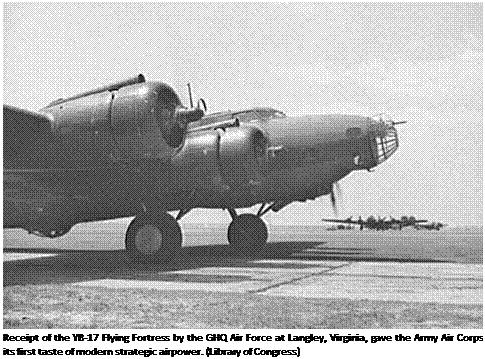1939
January 12 In Washington, D. C., President Franklin D. Roosevelt requests higher priority for the development and acquisition ofmodern military aircraft.
January 27 At March Field, California, the Lockheed XP-38 twin-boomed, twin-engined fighter performs its maiden flight. It enters service as the P-38 Lightning and serves throughout World War II with distinction.
FEBRUARY 10 Over Los Angeles, California, the North American NA-40 twin – engine bomber makes its initial flight. It enters service as the B-25 Mitchell and, during World War II, it becomes the most numerous medium bomber on the Allied side.
FEBRUARY 14 At Langley Field, Virginia, Major Caleb V. Haynes pilots the giant Boeing XB-15 prototype bomber during a mercy flight to assist earthquake victims in Chile. He arrives with 3,000 pounds of badly needed medical supplies in 29 hours and 53 minutes, winning a Mackay Trophy.
MARCH 1 At Langley Field, Virginia, Major General Delos C. Emmons is appointed commander of the General Headquarters force.
MARCH 21 A board of officers consisting of Colonel Hugo E. Pitz, Lieutenant Colonel Joseph T. McNarney, and Major George Kenney is assigned the task of evaluating permanent and auxiliary airfields in Puerto Rico.
MARCH 24 At Palm Springs, California, aviatrix Jacqueline Cochran sets another woman’s altitude record of 30,052 feet in her Beechcraft.
APRIL 3 In Washington, D. C., President Franklin D. Roosevelt signs the National Defense Act into law, which gives the Army Air Corps $300 million and authorizes its expansion to 48,000 personnel and 6,000 aircraft. Significantly, it also allows African Americans to receive flight training for the first time.
APRIL 18 Major General Henry H. Arnold recalls Colonel Charles A. Lindbergh of the Missouri National Guard back to active duty; he is tasked with evaluating and uncovering weaknesses in American air power.
APRIL 27 In Washington, D. C., the Army Air Corps places an order for the first production batch of Lockheed P-38 Lightnings.
JUNE 1 Major General Henry H. Arnold, chief of the Army Air Corps, seeks to acquire as large a pool of trained pilots as possible, so he authorizes civilian flying schools to accept flying cadets as pupils.
July 1 In Washington, D. C., President
Franklin D. Roosevelt issues an executive order mandating that the Aeronautical Board, the Joint Board (eventually Joint Chiefs of Staff), the Joint Economy Board, and the Munitions Board all function under the direction of the commander in chief.
JULY 15 The Army Air Corps acquires performance rights to the song “Wild Blue Yonder” by composer Robert Crawford; it subsequently becomes the theme song of the U. S. Air Force.
July 26 A Boeing B-17 Flying Fortress sets a new speed record of 204 miles per hour while carrying a 1,123-pound bomb
load over a closed triangular course of 1,000 kilometers.
JULY 30 Over Wright Field, Ohio, the sole Boeing XB-15, piloted by Major Caleb V. Haynes and Captain W. D. Olds, reaches 8,200 feet while carrying a 15.5 payload and establishes a new payload-to-altitude record.
AUGUST 1 A Boeing YB-17A flown by Majors Charles M. Cunnings and Stanley Umstead carries a 11,023-pound payload to a new record of 34,016 feet.
AUGUST 26 Majors Charles M. Cunnings and Stanley Umstead pilot a B-17A from Miami, Florida, to the Panama Canal Zone. It reaches its objective in only six hours and underscores American ability to reinforce that strategic point by air.
 |
September 14 In Connecticut, the VS – 300 helicopter, designed and flown by
Igor Sikorsky, reaches a height of three feet for 10 seconds during a tethered test.
SEPTEMBER 15 Over Burbank, California, a Seversky AP-9 piloted by aviatrix Jacqueline Cochran sets a new speed record of 309.5 miles per hour over a 1,000-kilometer course.
November 7 The 2nd Bomb Group receives the Mackay Trophy for its B-17 flight from Miami, Florida, to Buenos Aires, Argentina, and then home to Langley Field, Virginia.
December 16 At Langley Field, Virginia, Major General Delos C. Emmons gains appointment as chief of the General Headquarters Air Force (GHQ).
December 29 Over San Diego, California, the Consolidated XB-24 prototype performs its maiden flight. It enters service as the B-24 Liberator and becomes the most numerous American warplane, with over 18,000 constructed.










